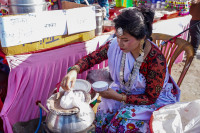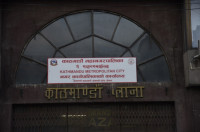Food
Where to eat in Bhaktapur
Walking from Tachapal Bhimsen, towards Nayatapola, it’s not unusual to see a man stooped over a karahi of boiling chaku, locals ducking through bed-sheet doorways to get their lunch, and others nibbling on sel roti with their tea.
Thomas Heaton
Explaining each and every morsel available in her little khaja ghar, petite Dimaya’s gap-toothed enthusiasm is infectious. In the shade of the Tachapal Bhimsen Temple in eastern Bhaktapur, Dimaya is obviously proud of her food. Her small eatery is not nearly as obvious as other restaurants and cafes, hidden in a quiet north-eastern corner, obscured by construction workers carting rocks past her front door.
“Haluwa, puri, papad,” she says, fingering each layer of this roll like a teacher. Filled with a smear of sweet haluwa, the chewy puri wrapper contrasts the brittle papad interior. Then, there’s her sel roti, different from others, smaller and less coarse; her jeri has a pronounced touch of salt and is not nearly as cloying as her counterparts’. If you’re lucky, this cheery didi will adopt you and, like many great mothers, will do her best to fatten you up.
Dimaya can be found through a short, stout doorway, surrounded by bowls of sweet and salty snacks. Opting to sit in the dimly lit interior, or on straw mats outside under the shade of the Tachapal Bhimsen, Dimaya will bring plate after plate of crispy bites if you don’t strongly refuse.
Bhaktapur, the tourist hub that it is, is full of restaurants and cafes and has everything to suit just about anyone’s proclivities. Like Patan, to truly taste Bhaktapur one must duck through doorways, meander its alleyways and explore the fringes. Around the primary sites, you can find the usual suspects being sold to tourists and locals—fried rice, momos, sandwiches and chowmein—but there is much more to the city’s food. Get out of the main area, shirk sanitation standards and enter a world of Newar flavour. Flavours of Newar culture appear in these places, not only in the gastronomical sense, and warmth like Dimaya’s can be felt.

Down the side roads and alleyways, everyday stores begin to emerge from tourist-centric roads. Mandala, thangka and khukuri galleries wane and butchers, grocers and tea shops appear. Negotiating human-dominated traffic, there is a brand of silence unique to Bhaktapur. Only interrupted by the staccato of drums echoing from distant religious ceremonies or clarinets’ whining from wedding processions, the city’s inner sanctum is mostly quiet and devoid of traffic.
Walking from Tachapal Bhimsen, towards Nayatapola, it’s not unusual to see a man stooped over a karahi of boiling chaku, locals ducking through bed-sheet doorways to get their lunch, and others nibbling on sel roti with their tea. Many shops sell paddle-like nimkis and fluorescent pink hyangu puri, for religious use, alongside sweet khajuri, blades of roti and garlands of lakhaamari. One such place, the Shrestha Mithai Bhandar, sells lalmohan and barfi decorated with silver leaves, pistachios and cherries. At the Jay Mata Fruit Centre, just next door, you will find enough jars of salty, spicy, sweet lapsi candy to make you salivate enough to feel hungry again.
Not far, down one indistinct alleyway, hardly 100 metres north-east of Nyatapola, a tiny restaurant serves the best of Newar food. With a small sign in Nepali outside the alleyway, next to another for a butcher, the Jiima Newari Khaja Ghar has just enough room for 10 people. The old men that frequent this place come for a reason. Chyang in one hand, a spoon in the other, they nibble shared plates of keema wo as the sun pours through a hole in the roof. Also known as bara, this dense lentil patty has an egg cracked into its centre and is pan fried. The fried egg ensures that the patties have crispy edges, and stand up to the meaty jhol on offer, even as the patties’ innards remain moist. Like Dimaya from the Tachapal Bhimsen Temple, the owners of this restaurant will ply you with as much food as you can bear. It might be dyakla, stewed fall-apart buffalo meat; kachila, minced raw buff mixed with spices; or a choila of blackened buff, tossed in an inferno-hot mix of chillies, ginger, garlic and coriander. The chyang does a lot to lessen the sting of this traditionally spicy Newar khaja, while the old men opt for their own wee bottles of whiskey. Another spot for wo is slightly more conspicuous, at the end of the alley behind Nyatapola.

With Bhaktapur spices leaving your tongue in cinders, there are only two things that can be prescribed. One is juju dhau, of course. The king of curds is as about as famous as the city, and for good reason. Many of the people selling juju dhau around Bhaktapur have been doing it for generations, so you know it’s going to be good. Rich from buffalo milk and sweet from copious amounts of sugar, it is served in tiny clay pots. The effervescent yogurt is velvety and lines the mouth just enough to extinguish any remaining flames from the previous plates.
Just in time for sunset, heading towards Bhaktapur Durbar Square, there is one place left. Tucked in a corner of eateries, where people scarf pani puri and get their potato fix at Aalucha, one of the best kulfis in town is sold. The grainy cardamom-spiced ice cream sold at Kulfi Sansar is the perfect accompaniment to the sun setting over the Pashupatinath and Vatsala Devi Temples, to help cool off from a day of incendiary Newar cuisine.




 5.27°C Kathmandu
5.27°C Kathmandu











